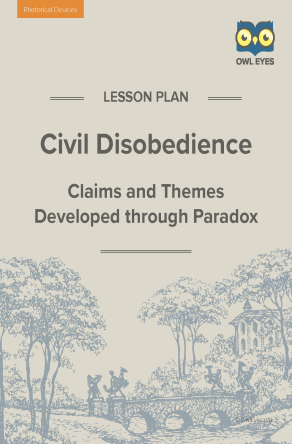Civil Disobedience Rhetorical Devices Lesson Plan
- 20 pages
- Subject: Literary Devices, Paradox, Rhetorical Devices, Themes, Lesson Plans and Educational Resources
- Common Core Standards: RI.9-10.1, RI.9-10.2, RI.9-10.4, RI.9-10.5, SL.9-10.1
- Grade Levels: 9, 10, 11, 12
Additional Civil Disobedience Resources
Product Description
Claims and Themes Developed through Paradox
This lesson plan focuses on Thoreau’s use of paradox in “Civil Disobedience.” Students will identify and analyze examples of paradox in passages from the text and explain the ideas they convey. By studying Thoreau’s use of paradox as a rhetorical device, students will be better able to identify and describe the major claims and themes in the essay.
Skills: close reading, interpreting figurative language and connotative meaning, drawing inferences and themes from a text
Learning Objectives: By the end of the lesson, students will be able to
- define and describe paradox as a rhetorical device
- identify and explain examples of paradox in the text
- explain how a paradox challenges readers’ perspectives and expresses an unconventional idea
- draw claims and themes from the text and explain how they are developed through paradox
About This Document
Owl Eyes lesson plans have been developed to meet the demanding needs of today’s educational environment and bridge the gap between online learning and in-class instruction. The main components of each plan include the following:
- An introduction to the text
- A step-by-step guide to lesson procedure
- Previous and following lesson synopses for preparation and extension ideas
- A collection of handouts complete with answer keys
Each of these comprehensive, 60-minute plans focus on promoting meaningful interaction, analytical skills, and student-centered activities, drawing from the Common Core Standards for English Language Arts and the expertise of classroom teachers.
Introduction to the Lesson
In July of 1846, while walking in his hometown of Concord, Massachusetts, Henry David Thoreau was arrested by Sam Staples, the town constable and tax collector.
For six years, Thoreau had refused to pay his poll tax, and when he declined once again, Staples put him in jail. News of Thoreau’s arrest spread quickly through the small community; the following morning he was released, the tax having been paid by an anonymous friend. Far from feeling ashamed of being arrested and jailed, Thoreau publicized the event in a speech he delivered in 1848, which he published in 1849 as an essay, “Resistance to Civil Government.” In later publications, the essay was titled “Civil Disobedience.”
Thoreau’s refusing to pay the tax, as he explains in the essay, was a personal moral stand against the Mexican-American War, which he viewed as an unjustified land grab by the United States that would ensure the spread of slavery westward. Paying the tax, he asserted, would make him morally complicit in the American government’s unjust actions. Like other members of the New England transcendentalism movement, Thoreau valued individualism; he believed that an individual, guided by conscience, must resist the demands of corrupt governments and institutions, even at the cost of losing personal freedom and property.
Thoreau understood that his philosophy did not align with that of traditional New England society, which valued deferring to the dictates of the law and of political and religious institutions. In “Civil Disobedience,” he argues for thinking independently and following one’s conscience in matters of moral principle, contending that to do otherwise results in the loss of spiritual integrity. Thoreau’s arguments are often developed through paradoxical statements that illustrate the contrary and novel aspects of his thinking. Employing paradox is an effective rhetorical strategy in the essay, for, by definition, a paradox contradicts prevailing assumptions or “common sense” to make room for a fresh idea or perspective. Through the use of paradox, Thoreau unsettles readers and draws them into considering his unconventional views.
After almost two centuries, “Civil Disobedience” continues to resonate with readers in its examination of the individual’s relationship to society and the state. During the 20th century, Mahatma Gandhi and Martin Luther King, Jr. each drew inspiration from Thoreau’s essay in leading revolutionary political movements through non-violent resistance to injustice in their respective countries. Harnessing the power of Thoreau’s philosophy, Gandhi led India to freedom from British rule, and King led the American Civil Rights movement to success in the 1960s. The enduring relevance of Thoreau’s 1849 essay can be attributed primarily to its themes, which are universal and timeless.
Worksheet Excerpt
Analyzing Paradox in “Civil Disobedience”: Passage 1
- Working with members of your group, examine this passage from the text and identify a paradox that is stated or implied.
- Discuss the paradox, and analyze it by completing the chart.
- Have one person in your group highlight the paradox in the text and write an annotation that explains the contradiction and the idea or truth conveyed in the paradox.
- Discuss the annotation as it is being written to make sure that it reflects the group’s analysis of the paradox.
Passage 1: “The broadest and most prevalent error requires the most disinterested virtue to sustain it. The slight reproach to which the virtue of patriotism is commonly liable, the noble are most likely to incur. Those who, while they disapprove of the character and measures of a government, yield to it their allegiance and support, are undoubtedly its most conscientious supporters, and so frequently the most serious obstacles to reform.”
- Quote the paradox or paraphrase if it is implied.
- How does the paradox seem to contradict logic, common sense, or prevailing attitudes?
- What idea or truth is conveyed in the paradox?







